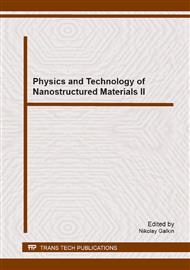[1]
C. C. Koch. Nanostructured Materials - Processing, Properties and Potential Applications, William Andrew Publishing/Noyes Publishing, New York, (2002).
Google Scholar
[2]
T. Ryu, H. Y. Sohn, K. S. Hwang, Z. Z. Fang, Chemical vapor synthesis and characterization of nanosized WC-Co composite powder and post-treatment, Ind. Eng. Chem. Res. 47 (2008) 9384-9385.
DOI: 10.1021/ie800322y
Google Scholar
[3]
L. Fu, L.H. Cao and Y.S. Fan, Two step synthesis of nanostructured tungsten carbide–cobalt powders, Scr. Mater. 44 (2001) 1061-1068.
DOI: 10.1016/s1359-6462(01)00668-6
Google Scholar
[4]
S. Lay, C.H. Allibert, M. Christensen, G. Wahnström, Morphology of WC grains in WC-Co alloys, Materials Science and Engineering A 486 (2008) 253-261.
DOI: 10.1016/j.msea.2007.09.019
Google Scholar
[5]
M. Christensen, G. Wahnström, S. Lay, C.H. Allibert, Morphology of WC grains in WC–Co alloys: Theoretical determination of grain shape, Acta Mater. 55 (2007) 1515-1521.
DOI: 10.1016/j.actamat.2006.10.013
Google Scholar
[6]
Y. Zhong, H. Zhu, L. L. Shaw, R. Ramprasad, The equilibrium morphology of WC particles – A combined ab initio and experimental study, Acta Mater. 59 (2011) 3748-3757.
DOI: 10.1016/j.actamat.2011.03.018
Google Scholar
[7]
A.A. Gnidenko, First principle simulation of the Co layers behavior on a surface of hexagonal tungsten carbide, Physics Procedia 23 (2012) 132-135.
DOI: 10.1016/j.phpro.2012.01.033
Google Scholar
[8]
W. Betteridge, The properties of metallic cobalt, Prog. Mater. Sci. 24 (1979) 51-142.
Google Scholar
[9]
A.A. Karimpoor, U. Erb, K.T. Aust, G. Palumbo, High strength nanocrystalline cobalt with high tensile ductility, Scripta Materialia. 49 (2003) 651–656.
DOI: 10.1016/s1359-6462(03)00397-x
Google Scholar
[10]
X. Gonze at al., ABINIT: First-principles approach to material and nanosystem properties, Computer Phys. Comm. 180 (2009) 2582-2634.
Google Scholar
[11]
H. Hohenberg, W. Kohn, Inhomogeneous Electron Gas, Phys. Rev. 136 (1964) B864-B871.
DOI: 10.1103/physrev.136.b864
Google Scholar
[12]
W. Kohn, J.L. Sham, Self-Consistent Equations Including Exchange and Correlation Effects, Phys. Rev. 140 (1965) A1133-A1138.
DOI: 10.1103/physrev.140.a1133
Google Scholar
[13]
M. Fuchs, M. Scheffler, Ab initio pseudopotentials for electronic structure calculations of poly-atomic systems using density functional theory, Comp. Phys. Commun. 119 (1999) 32-67.
DOI: 10.1016/s0010-4655(98)00201-x
Google Scholar
[14]
L.E. Toth. Transition Metal Carbides and Nitrides. Academic Press, New York, (1971).
Google Scholar
[15]
M. Lee and R. S. Gilmore, Single crystal elastic constants of tungsten monocarbide, J. Mater. Sci. 17 (1982) 2657-2660.
DOI: 10.1007/bf00543901
Google Scholar
[16]
H. L. Brown, P. E. Armstrong and C. P. Kempter, Elastic Properties of Some Polycrystalline Transition‐Metal Monocarbides, J. Chem. Phys. 45 (1966) 547-549.
DOI: 10.1063/1.1727602
Google Scholar
[17]
A. Buch. Pure Metals Properties. A Scientific-Technical Handbook. 1st edition, ASM International and Freund Publishing House Ltd., Ohio, (1999).
Google Scholar


